Thomas Lukasiewicz
A Survey on Tabular Data Generation: Utility, Alignment, Fidelity, Privacy, and Beyond
Mar 07, 2025Abstract:Generative modelling has become the standard approach for synthesising tabular data. However, different use cases demand synthetic data to comply with different requirements to be useful in practice. In this survey, we review deep generative modelling approaches for tabular data from the perspective of four types of requirements: utility of the synthetic data, alignment of the synthetic data with domain-specific knowledge, statistical fidelity of the synthetic data distribution compared to the real data distribution, and privacy-preserving capabilities. We group the approaches along two levels of granularity: (i) based on the primary type of requirements they address and (ii) according to the underlying model they utilise. Additionally, we summarise the appropriate evaluation methods for each requirement and the specific characteristics of each model type. Finally, we discuss future directions for the field, along with opportunities to improve the current evaluation methods. Overall, this survey can be seen as a user guide to tabular data generation: helping readers navigate available models and evaluation methods to find those best suited to their needs.
Shh, don't say that! Domain Certification in LLMs
Feb 26, 2025Abstract:Large language models (LLMs) are often deployed to perform constrained tasks, with narrow domains. For example, customer support bots can be built on top of LLMs, relying on their broad language understanding and capabilities to enhance performance. However, these LLMs are adversarially susceptible, potentially generating outputs outside the intended domain. To formalize, assess, and mitigate this risk, we introduce domain certification; a guarantee that accurately characterizes the out-of-domain behavior of language models. We then propose a simple yet effective approach, which we call VALID that provides adversarial bounds as a certificate. Finally, we evaluate our method across a diverse set of datasets, demonstrating that it yields meaningful certificates, which bound the probability of out-of-domain samples tightly with minimum penalty to refusal behavior.
* 10 pages, includes appendix Published in International Conference on Learning Representations (ICLR) 2025
Detection-Fusion for Knowledge Graph Extraction from Videos
Dec 30, 2024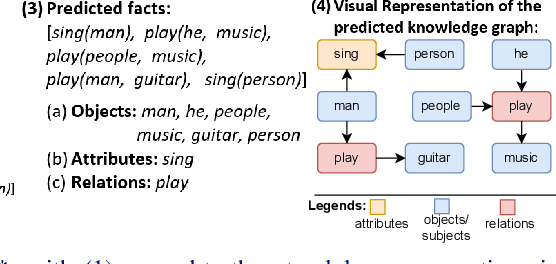



Abstract:One of the challenging tasks in the field of video understanding is extracting semantic content from video inputs. Most existing systems use language models to describe videos in natural language sentences, but this has several major shortcomings. Such systems can rely too heavily on the language model component and base their output on statistical regularities in natural language text rather than on the visual contents of the video. Additionally, natural language annotations cannot be readily processed by a computer, are difficult to evaluate with performance metrics and cannot be easily translated into a different natural language. In this paper, we propose a method to annotate videos with knowledge graphs, and so avoid these problems. Specifically, we propose a deep-learning-based model for this task that first predicts pairs of individuals and then the relations between them. Additionally, we propose an extension of our model for the inclusion of background knowledge in the construction of knowledge graphs.
Data for Mathematical Copilots: Better Ways of Presenting Proofs for Machine Learning
Dec 19, 2024

Abstract:The suite of datasets commonly used to train and evaluate the mathematical capabilities of AI-based mathematical copilots (primarily large language models) exhibit several shortcomings. These limitations include a restricted scope of mathematical complexity, typically not exceeding lower undergraduate-level mathematics, binary rating protocols and other issues, which makes comprehensive proof-based evaluation suites difficult. We systematically explore these limitations and contend that enhancing the capabilities of large language models, or any forthcoming advancements in AI-based mathematical assistants (copilots or "thought partners"), necessitates a paradigm shift in the design of mathematical datasets and the evaluation criteria of mathematical ability: It is necessary to move away from result-based datasets (theorem statement to theorem proof) and convert the rich facets of mathematical research practice to data LLMs can train on. Examples of these are mathematical workflows (sequences of atomic, potentially subfield-dependent tasks that are often performed when creating new mathematics), which are an important part of the proof-discovery process. Additionally, we advocate for mathematical dataset developers to consider the concept of "motivated proof", introduced by G. P\'olya in 1949, which can serve as a blueprint for datasets that offer a better proof learning signal, alleviating some of the mentioned limitations. Lastly, we introduce math datasheets for datasets, extending the general, dataset-agnostic variants of datasheets: We provide a questionnaire designed specifically for math datasets that we urge dataset creators to include with their datasets. This will make creators aware of potential limitations of their datasets while at the same time making it easy for readers to assess it from the point of view of training and evaluating mathematical copilots.
Fool Me Once? Contrasting Textual and Visual Explanations in a Clinical Decision-Support Setting
Oct 16, 2024



Abstract:The growing capabilities of AI models are leading to their wider use, including in safety-critical domains. Explainable AI (XAI) aims to make these models safer to use by making their inference process more transparent. However, current explainability methods are seldom evaluated in the way they are intended to be used: by real-world end users. To address this, we conducted a large-scale user study with 85 healthcare practitioners in the context of human-AI collaborative chest X-ray analysis. We evaluated three types of explanations: visual explanations (saliency maps), natural language explanations, and a combination of both modalities. We specifically examined how different explanation types influence users depending on whether the AI advice and explanations are factually correct. We find that text-based explanations lead to significant over-reliance, which is alleviated by combining them with saliency maps. We also observe that the quality of explanations, that is, how much factually correct information they entail, and how much this aligns with AI correctness, significantly impacts the usefulness of the different explanation types.
Affinity-Graph-Guided Contractive Learning for Pretext-Free Medical Image Segmentation with Minimal Annotation
Oct 14, 2024



Abstract:The combination of semi-supervised learning (SemiSL) and contrastive learning (CL) has been successful in medical image segmentation with limited annotations. However, these works often rely on pretext tasks that lack the specificity required for pixel-level segmentation, and still face overfitting issues due to insufficient supervision signals resulting from too few annotations. Therefore, this paper proposes an affinity-graph-guided semi-supervised contrastive learning framework (Semi-AGCL) by establishing additional affinity-graph-based supervision signals between the student and teacher network, to achieve medical image segmentation with minimal annotations without pretext. The framework first designs an average-patch-entropy-driven inter-patch sampling method, which can provide a robust initial feature space without relying on pretext tasks. Furthermore, the framework designs an affinity-graph-guided loss function, which can improve the quality of the learned representation and the model generalization ability by exploiting the inherent structure of the data, thus mitigating overfitting. Our experiments indicate that with merely 10% of the complete annotation set, our model approaches the accuracy of the fully annotated baseline, manifesting a marginal deviation of only 2.52%. Under the stringent conditions where only 5% of the annotations are employed, our model exhibits a significant enhancement in performance surpassing the second best baseline by 23.09% on the dice metric and achieving an improvement of 26.57% on the notably arduous CRAG and ACDC datasets.
Dimension-independent learning rates for high-dimensional classification problems
Sep 26, 2024
Abstract:We study the problem of approximating and estimating classification functions that have their decision boundary in the $RBV^2$ space. Functions of $RBV^2$ type arise naturally as solutions of regularized neural network learning problems and neural networks can approximate these functions without the curse of dimensionality. We modify existing results to show that every $RBV^2$ function can be approximated by a neural network with bounded weights. Thereafter, we prove the existence of a neural network with bounded weights approximating a classification function. And we leverage these bounds to quantify the estimation rates. Finally, we present a numerical study that analyzes the effect of different regularity conditions on the decision boundaries.
Benchmarking Predictive Coding Networks -- Made Simple
Jul 01, 2024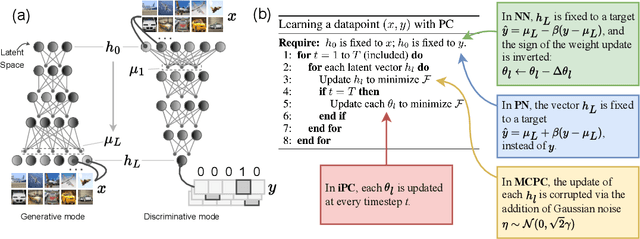
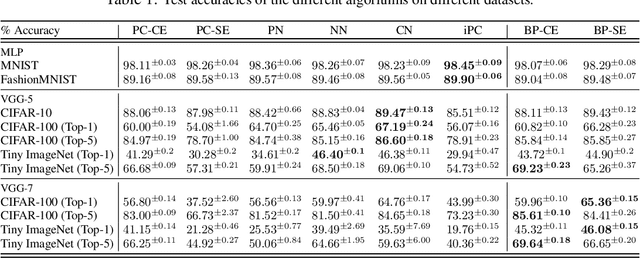

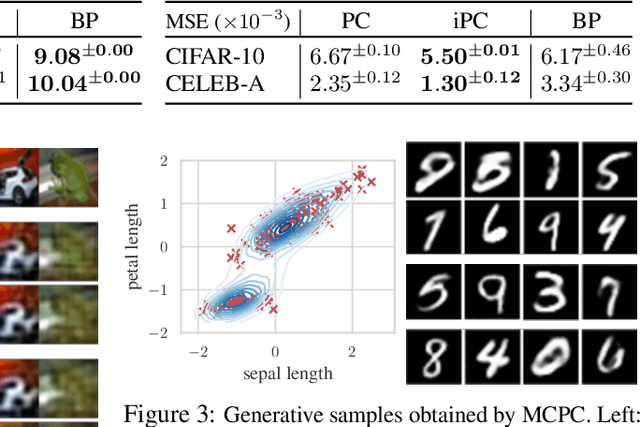
Abstract:In this work, we tackle the problems of efficiency and scalability for predictive coding networks in machine learning. To do so, we first propose a library called PCX, whose focus lies on performance and simplicity, and provides a user-friendly, deep-learning oriented interface. Second, we use PCX to implement a large set of benchmarks for the community to use for their experiments. As most works propose their own tasks and architectures, do not compare one against each other, and focus on small-scale tasks, a simple and fast open-source library adopted by the whole community would address all of these concerns. Third, we perform extensive benchmarks using multiple algorithms, setting new state-of-the-art results in multiple tasks and datasets, as well as highlighting limitations inherent to PC that should be addressed. Thanks to the efficiency of PCX, we are able to analyze larger architectures than commonly used, providing baselines to galvanize community efforts towards one of the main open problems in the field: scalability. The code for PCX is available at \textit{https://github.com/liukidar/pcax}.
Towards Certification of Uncertainty Calibration under Adversarial Attacks
May 22, 2024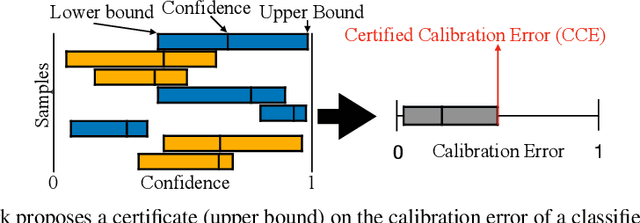
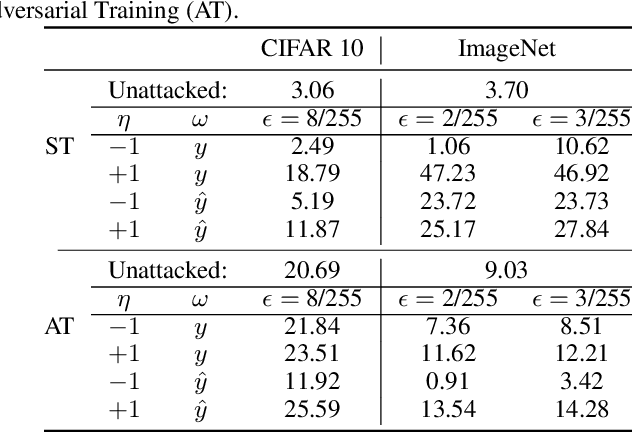
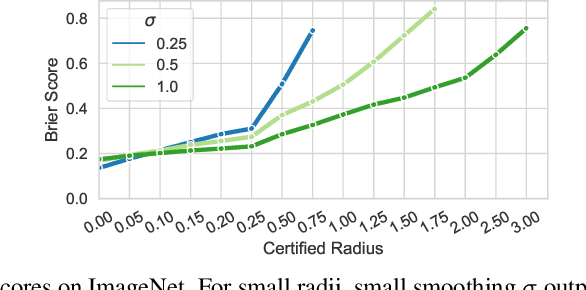
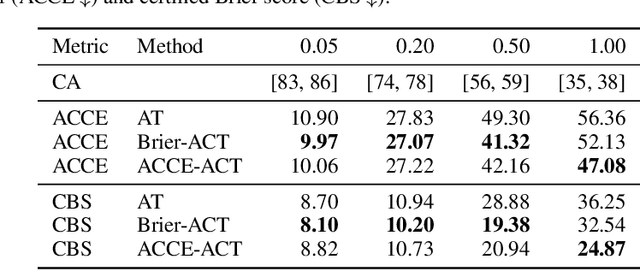
Abstract:Since neural classifiers are known to be sensitive to adversarial perturbations that alter their accuracy, \textit{certification methods} have been developed to provide provable guarantees on the insensitivity of their predictions to such perturbations. Furthermore, in safety-critical applications, the frequentist interpretation of the confidence of a classifier (also known as model calibration) can be of utmost importance. This property can be measured via the Brier score or the expected calibration error. We show that attacks can significantly harm calibration, and thus propose certified calibration as worst-case bounds on calibration under adversarial perturbations. Specifically, we produce analytic bounds for the Brier score and approximate bounds via the solution of a mixed-integer program on the expected calibration error. Finally, we propose novel calibration attacks and demonstrate how they can improve model calibration through \textit{adversarial calibration training}.
PiShield: A NeSy Framework for Learning with Requirements
Feb 28, 2024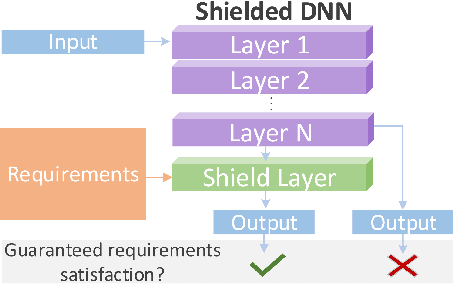

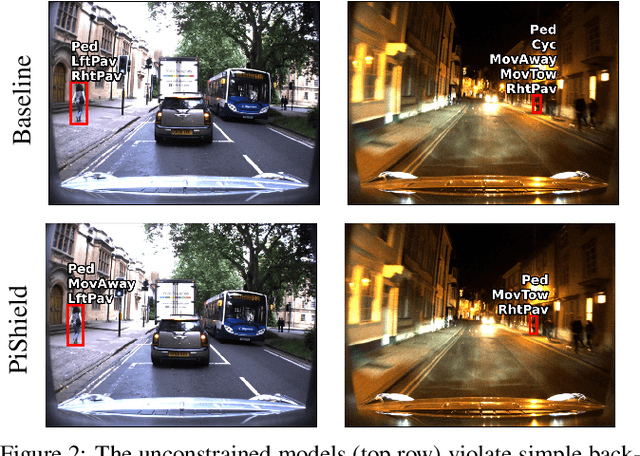
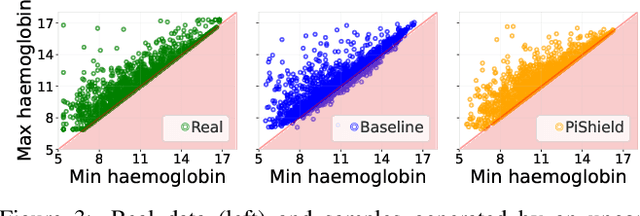
Abstract:Deep learning models have shown their strengths in various application domains, however, they often struggle to meet safety requirements for their outputs. In this paper, we introduce PiShield, the first framework ever allowing for the integration of the requirements into the neural networks' topology. PiShield guarantees compliance with these requirements, regardless of input. Additionally, it allows for integrating requirements both at inference and/or training time, depending on the practitioners' needs. Given the widespread application of deep learning, there is a growing need for frameworks allowing for the integration of the requirements across various domains. Here, we explore three application scenarios: functional genomics, autonomous driving, and tabular data generation.
 Add to Chrome
Add to Chrome Add to Firefox
Add to Firefox Add to Edge
Add to Edge